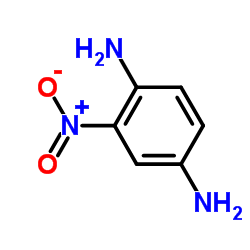2-Nitro-1,4-benzenediamine

2-Nitro-1,4-benzenediamine structure
|
Common Name | 2-Nitro-1,4-benzenediamine | ||
|---|---|---|---|---|
| CAS Number | 5307-14-2 | Molecular Weight | 153.139 | |
| Density | 1.4±0.1 g/cm3 | Boiling Point | 385.4±22.0 °C at 760 mmHg | |
| Molecular Formula | C6H7N3O2 | Melting Point | 135-138 °C(lit.) | |
| MSDS | Chinese USA | Flash Point | 186.9±22.3 °C | |
| Symbol |

GHS07 |
Signal Word | Warning | |
|
Teratogenic evaluation of 2-nitro-p-phenylenediamine, 4-nitro-o-phenylenediamine, and 2,5-toluenediamine sulfate in the mouse.
Teratology 24(3) , 253-65, (1981) Pregnant outbred albino (CD-1) mice were given 2-nitro-p-phenylenediamine (2NPPD; 32-256 mg/kg/day), 4-nitro-o-phenylenediamine (4NOPD; 16-1024 mg/kg/day) or 2,5-toluenediamine sulfate (2,5TDS; 16-64 mg/kg/day) by subcutaneous injection on Days 6-15 of gestat... |
|
|
Metabolism of the hair dye component, nitro-p-phenylenediamine, in the rat.
Chem. Pharm. Bull. 35(2) , 785-91, (1987)
|
|
|
Regioselective N-acetylation as a route of nitro-9-phenylenediamine metabolism by rat liver cytosol.
Chem. Pharm. Bull. 38(9) , 2561-6, (1990) Regioselectivity in N-acetylation of nitro-0-phenylenediamine, a widely used hair dye component, by rat liver cytosolic N-acetyltransferases was studied in relation to its substituent effects on enzymatic N-acetylation of mono-substituted anilines. Nitro-p-ph... |
|
|
Reductive metabolism of nitro-p-phenylenediamine by rat liver.
Chem. Pharm. Bull. 39(1) , 177-80, (1991) Reductive metabolism of the hair dye constituent, nitro-p-phenylenediamine (2-nitro-1,4-diaminobenzene, NPDA), and its acetylated metabolite, NPDA N4-acetate, was investigated with rat liver subcellular fractions, microsomes and cytosol. Under anaerobic condi... |
|
|
1,4-Diamino-2-nitrobenzene (2-nitro-para-phenylenediamine).
IARC Monogr. Eval. Carcinog. Risks Hum. 57 , 185-200, (1993)
|
|
|
In vivo skin penetration studies of 2,4-toluenediamine, 2,4-diaminoanisole, 2-nitro-p-phenylenediamine, p-dioxane and N-nitrosodiethanolamine in cosmetics.
Food Cosmet. Toxicol. 19(6) , 743-7, (1981)
|
|
|
Percutaneous absorption of nitroaromatic compounds: in vivo and in vitro studies in the human and monkey.
J. Invest. Dermatol. 84(3) , 180-3, (1985) The percutaneous absorption of 2-nitro-p-phenylene-diamine, 4-amino-2-nitrophenol, nitrobenzene, p-nitroaniline, and 2,4-dinitrochlorobenzene was measured through human and monkey skin. Human studies were performed with excised skin in diffusion cells. Absorp... |
|
|
Antimutagenicity of some citrus fruits in Salmonella typhimurium.
Mutat. Res. 222(3) , 141-8, (1989) The antimutagenic effect of 10 citrus fruit juices was observed against the mutagenicity of N-nitro-o-phenylenediamine (NPD) in TA97a and sodium azide in TA100 tester strains of Salmonella typhimurium using the Ames test. It was noticed that the juices of all... |
|
|
Studies on antimutagenic effects of guava (Psidium guajava) in Salmonella typhimurium.
Mutat. Res. 300(1) , 1-3, (1993) The water and chloroform extracts of guava were tested for their antimutagenicity. The water extract was effective in inactivating the mutagenicity of direct-acting mutagens, e.g., 4-nitro-o-phenylenediamine, sodium azide, and the S9-dependent mutagen, 2-amin... |
|
|
Mutagenicity and toxicity studies of p-phenylenediamine and its derivatives.
Toxicol. Lett. 81(1) , 23-32, (1995) The mutagenicity of p-phenylenediamine and its derivatives was tested using Ames Salmonella strains TA98 and TA100. p-Phenylenediamine was weakly mutagenic to TA98 with metabolic activation. 2-Nitro-p-phenylenediamine was directly mutagenic to both strains, w... |